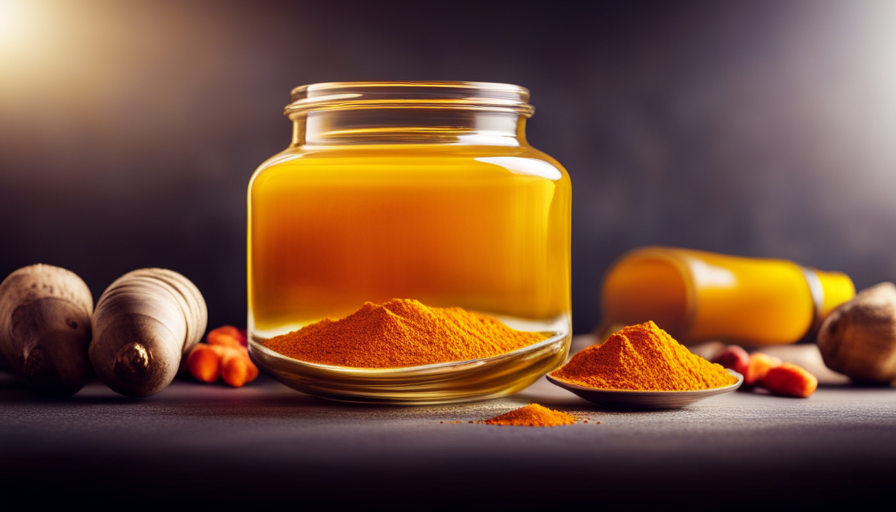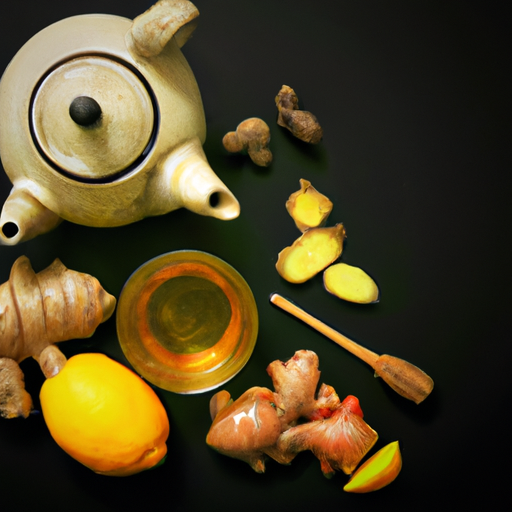As someone who is always looking for natural ways to improve my health, I recently discovered the incredible benefits of drinking turmeric powder. This bright yellow spice has been used for centuries in traditional medicine for its anti-inflammatory and antioxidant properties, and recent studies have confirmed its effectiveness in treating a wide range of health issues.
In this article, I will share with you everything you need to know about drinking turmeric powder, including how to choose the right type, how to prepare it, and some delicious and easy recipes to try. I will also discuss some potential side effects and offer tips for incorporating turmeric powder into your daily routine.
So if you’re ready to boost your health and wellness with this amazing spice, keep reading!
Key Takeaways
- Turmeric powder can be mixed with warm water or milk, and black pepper can enhance absorption.
- It is important to follow recommended dosage and start with a small amount to avoid potential side effects such as upset stomach, nausea, and diarrhea.
- Turmeric can be incorporated into daily life by making turmeric golden milk, tea, latte, infused water, or smoothies, and experimenting with different ingredients and flavors.
- Consult with a healthcare professional before incorporating turmeric into a routine, especially if taking medications or experiencing any health issues.
The Benefits of Drinking Turmeric Powder
Drinking turmeric powder can give you a burst of energy and a healthy glow, making it a great addition to your daily routine. The health benefits of turmeric powder are numerous, as it’s a powerful anti-inflammatory and antioxidant.
Turmeric can help improve brain function, reduce the risk of heart disease, and even potentially prevent cancer. It also has the ability to improve digestion and reduce joint pain. When it comes to dosage recommendations, it’s generally recommended to start with a small amount and gradually increase as your body becomes accustomed to it.
A good starting point is half a teaspoon of turmeric powder per day. However, it’s important to note that everyone’s body is different, so it’s best to consult with a healthcare professional before adding turmeric powder to your routine. With the right dosage and consistency, you can enjoy the many health benefits of turmeric powder.
In order to enjoy the full benefits of turmeric powder, it’s important to choose the right type. In the next section, we’ll discuss how to choose the right type of turmeric powder for your needs.
Choosing the Right Type of Turmeric Powder
When you’re at the store, choosing the right type of turmeric powder can be a little overwhelming. With so many brand options and sourcing concerns, it can be difficult to know which one is the best for you. Quality considerations are important, as some powders can contain potential contaminants. Additionally, you may want to compare the health benefits of different brands and consider the flavor profile for culinary uses.
Organic vs. conventional options are also something to keep in mind. Some people prefer organic turmeric powder because it’s grown without synthetic pesticides and fertilizers, while others may opt for conventional ones due to cost. Lastly, it’s important to consider the cultural significance of turmeric powder, as it’s been used in traditional medicine for centuries in some cultures.
When choosing the right type of turmeric powder, keep these factors in mind to ensure the best quality and health benefits.
To prepare turmeric powder for drinking, there are a few steps you can take. It’s important to store the powder in an airtight container away from moisture and light to maintain its potency. Dosage recommendations vary, but generally, one teaspoon of turmeric powder mixed with warm water or milk is a common serving size. Additionally, you may want to add a pinch of black pepper to enhance the body’s absorption of the turmeric’s active ingredient, curcumin.
With these tips, you can enjoy the health benefits of turmeric powder in a delicious and nutritious way.
How to Prepare Turmeric Powder for Drinking
To fully experience the health benefits and rich cultural history of turmeric powder, it’s important to properly prepare it for drinking. Here are the steps I follow to ensure the best flavor and maximum potency:
-
Choose the right grinding method: You can either purchase pre-ground turmeric powder or grind it yourself using a spice grinder. If you choose to grind it yourself, be sure to use a high-quality grinder to ensure a fine and even consistency.
-
Store it properly: Turmeric powder should be stored in an airtight container in a cool, dark place to prevent oxidation and loss of flavor. It’s best to use it within six months of purchase or grinding.
By following these simple steps, you can ensure you’re getting the most out of your turmeric powder drink. Next, let’s move on to some simple turmeric powder drink recipes.
Simple Turmeric Powder Drink Recipes
I love incorporating turmeric powder into my daily routine, and there are so many delicious ways to do it! Three of my favorite recipes are turmeric golden milk, turmeric tea, and turmeric smoothies.
Not only are these drinks tasty, but they also offer a variety of health benefits thanks to the anti-inflammatory properties of turmeric.
Let’s take a closer look at how to make each one.
Turmeric Golden Milk
If you’re feeling under the weather, sipping on a warm cup of turmeric golden milk can be just what the doctor ordered. Not only is this drink comforting and soothing, but it also provides a multitude of health benefits.
Turmeric, the main ingredient in golden milk, contains a compound called curcumin which has anti-inflammatory and antioxidant properties. These properties make it a powerful tool in fighting chronic diseases such as cancer, heart disease, and Alzheimer’s.
When making turmeric golden milk, there are a variety of flavor options to choose from. Some people prefer to add honey or maple syrup for sweetness, while others opt for a spicy kick with ginger or cinnamon. The basic recipe typically includes turmeric powder, coconut milk, and black pepper, which enhances the absorption of curcumin into the body. Simply mix the ingredients together in a saucepan and heat until warm.
Next up, let’s talk about another delicious way to enjoy the benefits of turmeric: turmeric tea.
Turmeric Tea
Sipping on a warm cup of turmeric tea is a soothing way to reap the health benefits of this powerful spice. Turmeric tea can be made by adding turmeric powder to hot water and allowing it to steep for a few minutes.
Here are some ways to spice up your turmeric tea:
- Add a splash of coconut milk for a creamy texture and tropical flavor.
- Mix in a pinch of cinnamon and honey for added sweetness and warmth.
Another popular way to consume turmeric is through a turmeric latte, also known as a golden latte. This creamy drink is made by combining turmeric powder with milk, coconut oil, and sweetener.
For a lighter drink, try turmeric infused water by simply adding turmeric powder to a glass of water and stirring until fully dissolved.
Transitioning into the next section, another delicious way to incorporate turmeric into your diet is through a turmeric smoothie.
Turmeric Smoothie
Blend up a creamy and vibrant smoothie with the anti-inflammatory benefits of turmeric, mixed with fresh fruits and yogurt. Turmeric smoothies are a delicious way to incorporate this superfood into your diet, and they are easy to make at home. One popular recipe is the turmeric and mango smoothie, which combines frozen mango chunks, yogurt, turmeric powder, and a dash of honey for sweetness. Another option is the turmeric and banana smoothie, which includes frozen banana slices, almond milk, turmeric powder, and a sprinkle of cinnamon.
To emphasize the health benefits of turmeric in smoothies, consider the following table:
| Health Benefits | Turmeric Smoothie |
|---|---|
| Anti-inflammatory | Turmeric powder reduces inflammation in the body |
| Antioxidant | Fresh fruits in smoothie provide antioxidants |
| Digestion aid | Yogurt in smoothie promotes healthy digestion |
| Immune booster | Turmeric powder improves immune function |
In addition to smoothies, turmeric can also be added to other drinks such as turmeric lattes. Experiment with different flavors and ingredients to create your own turmeric powder drink recipes.
Creating Your Own Turmeric Powder Drink Recipes
Explore your creativity and come up with your own delicious turmeric powder drink recipes that suit your taste buds. Not only will it be a fun and satisfying experience, but it will also allow you to take advantage of all the amazing turmeric powder drink benefits.
Turmeric is known for its anti-inflammatory and antioxidant properties, making it a great addition to any healthy diet. Plus, it adds a unique flavor and vibrant color to any drink.
One creative turmeric recipe is a golden milk latte. Simply heat up your choice of milk, add a teaspoon of turmeric powder, a pinch of black pepper, and a sweetener of your choice (such as honey or maple syrup). Blend together and enjoy a warm, comforting drink that is packed with health benefits.
Another idea is a tropical smoothie bowl, made with frozen pineapple, coconut milk, and a tablespoon of turmeric powder. Top with your favorite fruits and granola for a delicious and nutritious breakfast.
Don’t be afraid to experiment with different ingredients and flavors to create your own unique turmeric powder drink recipes that you can enjoy anytime, anywhere.
Incorporating turmeric powder into your daily routine can be easy and delicious. By exploring your creativity and coming up with your own turmeric powder drink recipes, you can reap the benefits of this powerful spice while enjoying a tasty beverage. However, there are also other tips and tricks that can help you incorporate turmeric into your daily life, which we’ll discuss in the next section.
Tips for Incorporating Turmeric Powder into Your Daily Routine
To incorporate more of this powerful spice into your daily routine, you can easily sprinkle a teaspoon of it onto your meals or add it to your favorite sauces or dressings. Turmeric supplements are also available, but it’s important to consult with your healthcare provider before taking them, especially if you’re on any medications or have any medical conditions.
Aside from consuming turmeric powder as a drink, there are alternative uses for this spice. For example, you can mix it with honey and use it as a face mask for its anti-inflammatory and antioxidant properties. You can also add it to your toothpaste for its natural teeth whitening abilities.
However, before using turmeric powder in any way, it’s important to be aware of potential side effects, which we will discuss in the next section.
Potential Side Effects of Drinking Turmeric Powder
Now that we’ve covered some tips for incorporating turmeric powder into your daily routine, it’s important to address the potential side effects that could come with drinking it. There are some common misconceptions about the side effects of turmeric powder, so it’s important to have accurate information in order to minimize any risks.
To start, let’s take a look at a table that outlines some of the possible side effects of turmeric powder and their likelihood:
| Side Effect | Likelihood of Occurrence |
|---|---|
| Upset Stomach | Common |
| Nausea | Common |
| Diarrhea | Common |
| Headache | Rare |
| Skin Irritation | Rare |
As you can see, the most common side effects of turmeric powder are related to the digestive system, such as upset stomach, nausea, and diarrhea. However, it’s important to note that these side effects are typically mild and temporary. Some people may also experience rare side effects such as headaches or skin irritation.
To minimize the risk of experiencing these side effects, it’s important to follow the recommended dosage and to start with a small amount of turmeric powder before gradually increasing it. It’s also a good idea to drink plenty of water when consuming turmeric powder and to avoid taking it on an empty stomach. If you are pregnant, nursing, or have a medical condition, it’s important to consult with a healthcare professional before consuming turmeric powder.
Consulting with a Healthcare Professional
Before incorporating any new supplement into my routine, it’s always a good idea to consult with a healthcare professional to ensure it’s safe for me. This is especially important when it comes to turmeric, as it may interact with certain medications and could potentially cause adverse effects if taken in large doses.
In addition, the importance of dosage cannot be overstated, as too much turmeric powder can lead to stomach upset and even liver damage.
When consulting with a healthcare professional about incorporating turmeric powder into my routine, I should be sure to let them know about any medications I’m currently taking. This will help them determine whether or not turmeric may interact with these medications and whether or not it’s safe for me to take.
In addition, they can provide guidance on the appropriate dosage and how often I should take it to receive maximum benefits while minimizing the risk of side effects.
With the guidance of a healthcare professional, I can safely incorporate turmeric powder into my routine to reap its numerous health benefits. However, if drinking turmeric powder isn’t for me, there are other ways to incorporate turmeric into my diet that I can explore.
Other Ways to Incorporate Turmeric into Your Diet
There are plenty of tasty and creative ways to add the health benefits of turmeric to your daily meals and snacks. Here are some ideas that you can try:
-
Make a turmeric latte by mixing turmeric powder with warm milk and a bit of honey. This is a great alternative to coffee and provides a warming and comforting drink.
-
Use turmeric as a seasoning for roasted vegetables, meat, or tofu. Turmeric adds a delicious and earthy flavor to any dish.
-
Add turmeric to your smoothies or juices. You can also add ginger, lemon, and honey to make a refreshing and healthy drink.
-
Incorporate turmeric into your salad dressings or dips. You can mix turmeric powder with olive oil, lemon juice, and garlic for a delicious and healthy dressing.
-
Make a turmeric tea by boiling water and adding turmeric powder, ginger, and honey. This is a great way to enjoy the health benefits of turmeric while relaxing and unwinding.
Turmeric is a versatile and delicious spice that can be easily incorporated into your diet. Whether you prefer a warming turmeric latte or a refreshing turmeric smoothie, there’s a way to enjoy the health benefits of turmeric in a way that suits your taste. So, why not try adding some turmeric seasoning to your next meal or snack and see how you feel?
Frequently Asked Questions
Is it safe to drink turmeric powder every day?
As I consume turmeric powder daily, I find that the benefits outweigh the risks. Studies suggest that turmeric has anti-inflammatory and antioxidant properties, potentially lowering the risk of chronic diseases. However, excessive consumption may lead to gastrointestinal issues.
Can turmeric powder be mixed with hot or cold water?
Turmeric powder can be mixed with hot or cold water, but hot water may enhance absorption. Adding lemon juice can improve flavor and increase absorption. Discuss with a healthcare professional before consuming daily.
How long does it take to see the benefits of drinking turmeric powder?
I started incorporating turmeric powder into my routine and noticed a decrease in joint pain after three weeks. The turmeric powder benefits timeline varies, but consistency is key. Include it in meals or mix with warm milk for best results.
Can turmeric powder be added to smoothies or other drinks?
Yes, turmeric powder can be added to smoothies and other drinks to reap its health benefits. Some recommended turmeric powder smoothie recipes include banana-turmeric smoothie and turmeric latte. These are among the best ways to incorporate turmeric powder into your drinks.
Is there a recommended dosage for drinking turmeric powder?
Before consuming turmeric powder, it’s important to know the recommended dosage to avoid potential risks. A daily intake of 500-2,000mg of curcumin can offer benefits such as reducing inflammation and improving brain function. However, excessive consumption can cause digestive issues and interact with certain medications.
Conclusion
In conclusion, incorporating turmeric powder into your daily routine can have a multitude of health benefits. Turmeric has been used for centuries as a natural remedy, from reducing inflammation to improving brain function. Choosing the right type of turmeric powder and preparing it correctly can make all the difference in the effectiveness of the drink.
By trying out different recipes and finding what works best for you, you can create a delicious and healthy drink that will become a staple in your daily routine. So go ahead and give it a try, and see for yourself the transformative effects that turmeric powder can have on your overall health and wellbeing.
It’s like a golden elixir that can work wonders for your body and mind!










